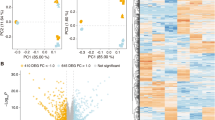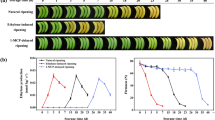Abstract
Main conclusion
CcBLH6 is a bell-like homeodomain-containing transcription factor that plays an important role of lignin biosynthesis in the control of fruit lignification pattern in Camellia chekiangoleosa.
Abstract
The fruit of Camellia chekiangoleosa has a unique lignification pattern that features with a thick pericarp containing a low level of lignification. Yet the fruit lignification pattern and the regulatory network of responsible gene transcription are poorly understood. Here, we characterized a bell-like homeodomain-containing (BLH) transcription factor from C. chekiangoleosa, CcBLH6, in the control of fruit lignification. CcBLH6 expression was highly correlated with the unique lignification pattern during fruit development. The ectopic expression of CcBLH6 promoted the lignification process of stem and root in Arabidopsis. We found that expression of genes related to lignin biosynthesis and its transcriptional regulation was altered in transgenic lines. In a Camellia callus-transformation system, overexpression of CcBLH6 greatly enhanced the expression of genes related to lignin biosynthesis and its transcriptional regulation was altered in transgenic lines. In the callus-transformation system, overexpression of CcBLH6 greatly enhanced the lignification of parenchymal cells, and the regulation of several genes involved in lignin accumulation was largely consistent between Arabidopsis and Camellia. Our study reveals a positive role of CcBLH6 in the regulation of lignin biosynthesis during fruit lignification in Camellia.






Similar content being viewed by others
Abbreviations
- BLH:
-
BEL1-Like Homeodomain
- KNOX:
-
Knotted-Like Homeodomain
- TALE:
-
Three Amino-acid Loop Extension
- PAL:
-
Phenylalanine Ammonia-Lyase
- C4H:
-
Cinnamate 4-Hydroxylase
- LAC:
-
Laccase
References
Arnaud N, Pautot V (2014) Ring the BELL and tie the KNOX: roles for TALEs in gynoecium development. Front Plant Sci 5:93
Barciela J, Vieitez AM (1993) Anatomical sequence and morphometric analysis during somatic embryogenesis on cultured cotyledon explants of Camellia japonica L. Ann Bot 71(5):395–404
Bencivenga S, Serrano-Mislata A, Bush M, Fox S, Sablowski R (2016) Control of oriented tissue growth through repression of organ boundary genes promotes stem morphogenesis. Dev cell 39(2):198–208
Boerjan W, Ralph J, Baucher M (2003) Lignin biosynthesis. Annu Rev Plant Biol 54(1):519–546
Clough SJ, Bent AF (1998) Floral dip: a simplified method for Agrobacterium-mediated transformation of Arabidopsis thaliana. Plant J 16(6):735–743
Dardick C, Callahan AM (2014) Evolution of the fruit endocarp: molecular mechanisms underlying adaptations in seed protection and dispersal strategies. Front Plant Sci 5:284–284
Dardick C, Callahan AM, Chiozzotto R, Schaffer RJ, Piagnani MC, Scorza R (2010) Stone formation in peach fruit exhibits spatial coordination of the lignin and flavonoid pathways and similarity to Arabidopsis dehiscence. BMC Biol 8:13
Dinneny JR, Yanofsky MF (2005) Drawing lines and borders: how the dehiscent fruit of Arabidopsis is patterned. BioEssays 27(1):42–49
Fan ZQ, Li JY, Li XL, Wu B, Wang JY, Liu ZC, Yin HF (2015) Genome-wide transcriptome profiling provides insights into floral bud development of summer-flowering Camellia azalea. Sci Rep 5:9729
Ferrandiz C (2002) Regulation of fruit dehiscence in Arabidopsis. J Exp Bot 53(377):2031–2038
Ferrandiz C, Fourquin C (2014) Role of the FUL-SHP network in the evolution of fruit morphology and function. J Exp Bot 65(16):4505–4513
Ferrandiz C, Liljegren SJ, Yanofsky MF (2000) Negative regulation of the SHATTERPROOF genes by FRUITFULL during Arabidopsis fruit development. Science 289(5478):436–438
Ferrándiz C, Fourquin C (2014) Role of the FUL-SHP network in the evolution of fruit morphology and function. J Exp Bot 65(16):4505–4513
Fraser CM, Chapple C (2011) The phenylpropanoid pathway in Arabidopsis. Arabidopsis Book 9:e0152
Garceau DC, Batson MK, Pan IL (2017) Variations on a theme in fruit development: the PLE lineage of MADS-box genes in tomato (TAGL1) and other species. Planta 246(2):313–321
Gillaspy G, Ben-David H, Gruissem W (1993) Fruits: a developmental perspective. Plant Cell 5(10):1439–1451
Girin T, Sorefan K, Østergaard L (2009) Meristematic sculpting in fruit development. J Exp Bot 60(5):1493–1502
Hamant O, Pautot V (2010) Plant development: a TALE story. Cr Biol 333(4):371–381
Hay A, Tsiantis M (2009) A KNOX familyn TALE. Curr Opin Plant Biol 12(5):593–598
Hirano K, Kondo M, Aya K, Miyao A, Sato Y, Antonio BA, Namiki N, Nagamura Y, Matsuoka M (2013) Identification of transcription factors involved in rice secondary cell wall formation. Plant Cell Physiol 54(11):1791–1802
Hu ZK, Lyu T, Yan C, Wang YP, Yin HF (2020) Identification of alternatively spliced gene isoforms and novel noncoding RNAs by single-molecule long-read sequencing in Camellia. RNA Biol 17(7):966–976
Kourmpetli S, Drea S (2013) The fruit, the whole fruit, and everything about the fruit. J Exp Bot 65(16):4491–4503
Kumar S, Stecher G, Tamura K (2016) MEGA7: Molecular evolutionary genetics analysis version 70 for bigger datasets. Mol Biol Evol 33(7):1870–1874
Letunic I, Doerks T, Bork P (2009) SMART 6: Recent updates and new developments. Nucleic Acids Res 37(S1):D229–D232
Li MT, Cheng CX, Zhang XF, Zhou SP, Wang CH, Ma CH, Yang SL (2019) PpNAC187 enhances lignin synthesis in ‘Whangkeumbae’ pear (Pyrus pyrifolia) ‘Hard-End’ fruit. Molecules 24(23):4338
Liljegren SJ, Ditta GS, Eshed Y, Savidge B, Yanofsky MF (2000) SHATTERPROOF MADS-box genes control seed dispersal in Arabidopsis. Nature 404(6779):766–770
Liu YY, Douglas CJ (2015) A role for OVATE FAMILY PROTEIN1 (OFP1) and OFP4 in a BLH6-KNAT7 multi-protein complex regulating secondary cell wall formation in Arabidopsis thaliana. Plant Signal Behav 10(7):e1033126
Liu YY, You SJ, Taylor-Teeples M, Li WL, Schuetz M, Brady SM, Douglas CJ (2014) BEL1-LIKE HOMEODOMAIN6 and KNOTTED ARABIDOPSIS THALIANA7 interact and regulate secondary cell wall formation via repression of REVOLUTA. Plant Cell 26(12):4843–4861
Liu QQ, Luo L, Zheng LP (2018) Lignins: biosynthesis and biological functions in plants. Int J Mol Sci 19(2):335
Livak KJ, Schmittgen TD (2002) Analysis of relative gene expression data using real-time quantitative PCR and the 2−ΔΔCT method. Methods 25(4):402–408
Lyu T, Fan ZQ, Yang W, Yan C, Hu ZK, Li XL, Li JY, Yin HF (2019) CjPLE, a PLENA-like gene, is a potential regulator of fruit development via activating the FRUITFUL homolog in Camellia. J Exp Bot 70(12):3153–3164
Pabón-Mora N, Wong GK, Ambrose BA (2014) Evolution of fruit development genes in flowering plants. Front Plant Sci 5:300
Rao XL, Dixon RA (2018) Current models for transcriptional regulation of secondary cell wall biosynthesis in grasses. Front Plant Sci 9:399
Roeder AHK, Ferrandiz C, Yanofsky MF (2003) The role of the REPLUMLESS homeodomain protein in patterning the Arabidopsis fruit. Curr Biol 13(18):1630–1635
Seymour GB, Østergaard L, Chapman NH, Knapp S, Martin C (2013) Fruit development and ripening. Annu Rev Plant Biol 64:219–241
Spjut RW (1994) A systematic treatment of fruit types. New York Botanical Garden, New York, p 182
Wang L, Li J, Zhao J, He CY (2015) Evolutionary developmental genetics of fruit morphological variation within the Solanaceae. Front Plant Sci 6:248
Wang JP, Matthews ML, Williams CM, Shi R, Yang CM, Tunlaya-Anukit S, Chen HC, Li QZ, Liu J, Lin CY, Naik P, Sun YH, Loziuk PL, Yeh TF, Kim H, Gjersing E, Shollenberger T, Shuford CM, Song J, Miller Z, Huang YY, Edmunds CW, Liu BG, Sun Y, Lin YCJ, Li W, Chen H, Peszlen I, Ducoste JJ, Ralph J, Chang HM, Muddiman DC, Davis MF, Smith C, Isik F, Sederoff R, Chiang VL (2018) Improving wood properties for wood utilization through multi-omics integration in lignin biosynthesis. Nat Commun 9(1):1579
Weng JK, Akiyama T, Bonawitz ND, Li X, Ralph J, Chapple C (2010) Convergent evolution of syringyl lignin biosynthesis via distinct pathways in the lycophyte Selaginella and flowering Plants. Plant Cell 22(4):1033–1045
Xie M, Zhang J, Tschaplinski TJ, Tuskan GA, Chen JG, Muchero W (2018) Regulation of lignin biosynthesis and its role in growth-defense tradeoffs. Front Plant Sci 9:1427
Xue C, Yao JL, Qin MF, Zhang MY, Allan AC, Wang DF, Wu J (2018) PbrmiR397a regulates lignification during stone cell development in pear fruit. Plant Biotechnol J 17(1):103–117
Xue C, Yao JL, Xue YS, Su GQ, Wang L, Lin LK, Allan AC, Zhang SL, Wu J (2019) PbrMYB169 positively regulates lignification of stone cells in pear fruit. J Exp Bot 70(6):1801–1814
Yan C, Lin P, Lyu T, Hu ZK, Fan ZQ, Li XL, Yao XH, Li JY, Yin HF (2018) Unraveling the roles of regulatory genes during domestication of cultivated Camellia: evidence and insights from comparative and evolutionary genomics. Genes 9(10):488
Yoon J, Cho LH, Kim SL, Choi H, Koh HJ, An G (2014) The BEL1-type homeobox gene SH5 induces seed shattering by enhancing abscission-zone development and inhibiting lignin biosynthesis. Plant J 79(5):717–728
Zhang J, Ge H, Zang C, Li X, Grierson D, Chen KS, Yin XR (2016) EjODO1, a MYB transcription factor, regulating lignin biosynthesis in developing loquat (Eriobotrya japonica) fruit. Front Plant Sci 7:1360
Zhao Q, Dixon RA (2011) Transcriptional networks for lignin biosynthesis: more complex than we thought? Trends Plant Sci 6(14):227–233
Zhong RQ, Ye ZH (2015) Secondary cell walls: Biosynthesis, patterned deposition and transcriptional regulation. Plant Cell Physiol 56(2):195–214
Acknowledgements
We would like to thank Dr. Haiping Yu from China National Rice Research Institute (Hangzhou, China) for technical supports on the confocal microscopy analysis. This work was supported by National Key R&D Program of China (2019YFD1000400 and 2019YFD1001602), Nonprofit Research Projects (CAFYBB2018QA005, CAFYBB2018QA006) of Chinese Academy of Forestry, and National Science Foundation of China (31870578).
Author information
Authors and Affiliations
Corresponding authors
Additional information
Communicated by Dorothea Bartels.
Publisher's Note
Springer Nature remains neutral with regard to jurisdictional claims in published maps and institutional affiliations.
Supplementary Information
Below is the link to the electronic supplementary material.
425_2021_3610_MOESM1_ESM.jpg
Supplementary Fig. S1 Overexpression of CcBLH6 in Arabidopsis causes pleiotropic effects on development and growth. a Comparison of overall morphology of WT and transgenic lines. Bar = 1 cm. b Validation of the Arabidopsis transgenic lines by the PCR amplification using construct-specific primers. The red arrow indicates the specific PCR product from the construct. c Four lines that displayed overexpression of CcBLH6 are identified by the QRT-PCR analysis (JPG 1382 KB)
425_2021_3610_MOESM2_ESM.jpg
Supplementary Fig. S2 Overexpression of CcBLH6 promoted the cell lignification in roots of transgenic lines. The histological analysis of root morphology in WT (a), and transgenic lines (b, c). The lignified areas are indicated by the red staining. d The areas of three individuals of transgenic lines from the T2 generation are compared based on the image analysis of cross sections. Bars = 100 µm. Error bars indicate ±SD. Significance tests are performed by one-way ANOVA. Different letters indicate significant variation (P<0.05) (JPG 1676 KB)
425_2021_3610_MOESM3_ESM.jpg
Supplementary Fig. S3 Validation of transformed callus lines in Camellia. a Six independent callus lines are used for PCR validation by using construct-specific primers. The red arrow indicates the construct-specific PCR product. b Three lines are used for QRT-PCR analysis for CcBLH6 expression levels. All quantifications are performed for three times. Significance tests are performed by (P<0.05) and indicated by different letters. CB0-CB5 are independent transgenic calli lines of Camellia; and Ca1-Ca3 are three control calli lines (JPG 1785 KB)
Rights and permissions
About this article
Cite this article
Yan, C., Hu, Z., Nie, Z. et al. CcBLH6, a bell-like homeodomain-containing transcription factor, regulates the fruit lignification pattern. Planta 253, 90 (2021). https://doi.org/10.1007/s00425-021-03610-7
Received:
Accepted:
Published:
DOI: https://doi.org/10.1007/s00425-021-03610-7




